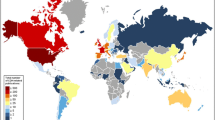Abstract
Available information on the global distribution of research output in pediatric cardiology (PC) is sparse. This study took a bibliometric approach to characterize research output, assess the level of competition, describe the geographic distribution of the leading research centers in the field, and investigate determinants of research output. In addition, the study characterized the journals publishing PC research and identified temporal trends in research interest over time. Publications presenting original research in PC between 1995 and 2011 were identified. A total of 9,410 relevant articles were identified based on a PubMed search followed by subsequent electronic filtering and manual review. A dramatic increase in PC publications was seen during the study period (from 309 in 1995 to 1,075 in 2011). This was accompanied by an increase in impact factors and an overproportional rise in PC contributions relative to the general PubMed trend. Research in PC was shown to be highly competitive and becoming increasingly so (Herfindahl–Hirschman index of 1.64 %). Research output correlated with gross domestic product, national levels of corruption, education, urbanization, geography, and presence of national centers of excellence. The data presented in this report allow benchmarking of different cities and countries and provide insights into the potential determinants of high-quality publications and the spectrum of publishing journals. The report also highlights the central role of subspecialty journals and shows that PC research output is related to national wealth, surrogates of appropriate use of resources, an adequate workforce, and education. Additionally, it emphasizes the potential beneficial effects of establishing centers of excellence in the field.








Similar content being viewed by others
References
Ashford LS (2007) Africa’s youthful population: risk or opportunity?. Population Reference Bureau, Washington, DC
Atallah J, Dinu IA, Joffe AR et al (2008) Two-year survival and mental and psychomotor outcomes after the Norwood procedure: an analysis of the modified Blalock–Taussig shunt and right ventricle-to-pulmonary artery shunt surgical eras. Circulation 118:1410–1418
Bakoush O, Al-Tubuly A, Ashammakhi N, Elkhammas E (2007) PubMed Medical publications from Libya. Libyan J Med 2:125–128
Barro RJ, Lee JW (2013) A new data set of educational attainment in the world, 1950–2010. J Dev Econ 104:184–198
Baumgartner H, Bonhoeffer P, De Groot NM et al (2010) ESC guidelines for the management of grown-up congenital heart disease (new version 2010). Eur Heart J 31:2915–2957
Clark J, Smith R (2003) BMJ Publishing Group to launch an international campaign to promote academic medicine. BMJ 327:1001–1002
Clark J, Tugwell P (2004) Who cares about academic medicine? BMJ 329:751–752
Commission USDoJatFT (2010). Horizontal Merger Guidelines. http://www.justice.gov/atr/public/guidelines/hmg-2010.pdf. Accessed 15 May 2013
Fontan F, Baudet E (1971) Surgical repair of tricuspid atresia. Thorax 26:240–248
Goldacre M, Stear S, Richards R, Sidebottom E (1999) Junior doctors’ views about careers in academic medicine. Med Educ 33:318–326
International Monetary Fund (2013) World Economic and Financial Surveys. World Economic Outlook (WEO). http://www.imf.org/external/pubs/ft/weo/2013/02/. Accessed 9 Dec 2013
Ioannidis JPA (2004) Academic medicine: the evidence base. Br Med J 329:789–792
Jatene AD, Fontes VF, Paulista PP et al (1975) Successful anatomic correction of transposition of the great vessels: a preliminary report. Arq Bras Cardiol 28:461–464
Kempny A, Fernandez-Jimenez R, Tutarel O et al (2013) Meeting the challenge: the evolving global landscape of adult congenital heart disease. Int J Cardiol 168:5182–5189
Kennedy N, Miller P (2013) The spectrum of paediatric cardiac disease presenting to an outpatient clinic in Malawi. BMC Res Notes 6:53
Lillehei CW, Cohen M, Warden HE et al (1955) Direct vision intracardiac surgical correction of the tetralogy of Fallot, pentalogy of Fallot, and pulmonary atresia defects: report of first ten cases. Ann Surg 142:418–442
Macmahon B, McKeown T, Record RG (1953) The incidence and life expectation of children with congenital heart disease. Br Heart J 15:121–129
Moons P, Bovijn L, Budts W, Belmans A, Gewillig M (2010) Temporal trends in survival to adulthood among patients born with congenital heart disease from 1970 to 1992 in Belgium. Circulation 122:2264–2272
Mustard WT, Chute AL, Keith JD, Sirek A, Rowe RD, Vlad P (1954) A surgical approach to transposition of the great vessels with extracorporeal circuit. Surgery 36:31–51
Pritchett L, Summers LH (1996) Wealthier is healthier. J Hum Resour 31:841–868
Rashkind WJ (1969) Atrial septostomy in congenital heart disease. Adv Pediatr 16:211–232
Rhoades SA (1993) Herfindahl–Hirschman Index. Fed Res Bull 79:188
Saxena A (2009) Congenital cardiac surgery in the less privileged regions of the world. Expert Rev Cardiovasc Ther 7:1621–1629
Warnes CA, Williams RG, Bashore TM et al (2008) ACC/AHA 2008 Guidelines for the Management of Adults with Congenital Heart Disease: a report of the American College of Cardiology/American Heart Association Task Force on Practice Guidelines (writing committee to develop guidelines on the management of adults with congenital heart disease). Circulation 118:e714–e833
Wernovsky G (2012) 11th Annual William J. Rashkind Memorial Lecture in paediatric cardiology: a short history of progress: where we’ve been, where we are, where we’re going. Cardiol Young 22:813–822
Acknowledgments
This project was kindly supported by the Karla Völlm charitable foundation (EMAH Stiftung Karla Völlm), Krefeld, Germany.
Conflict of interest
None.
Author information
Authors and Affiliations
Corresponding author
Electronic supplementary material
Below is the link to the electronic supplementary material.
Rights and permissions
About this article
Cite this article
Bräutigam, M., Kempny, A., Radke, R. et al. Spatial and Temporal Overview of Research in Pediatric and Congenital Cardiology: Trends and Global Challenges. Pediatr Cardiol 35, 1007–1019 (2014). https://doi.org/10.1007/s00246-014-0889-3
Received:
Accepted:
Published:
Issue Date:
DOI: https://doi.org/10.1007/s00246-014-0889-3




